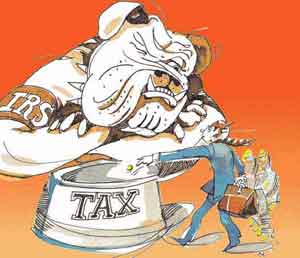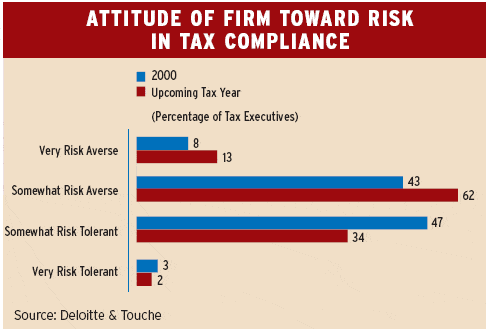As regulators and tax collection authorities clamp down on corporate and individual tax abuse, business leaders are finding it harder than ever to know where to draw the line between tax planning and tax evasion.

In recent months a great deal of attention has focused on the use of tax shelters.Part of the reason is that the US Internal Revenue Service (IRS) is ratcheting up and making plenty of noise aboutits efforts to curtail the use of abusive tax shelters.At the same time, a number of US senators have begun complaining loudly about corporations and individuals who are using tax shelters to help them shirk their share of the nations taxes.
Their ire has been raised by a perception that in recent years the abuse of legitimate tax breaks has reached epi- demic proportions.And, to an extent, they are right. One expert on tax accounting, who asked not to be named, says:There has been a mindset change in the past few years in terms of how far people are prepared to go to minimize their taxes. It was driven by investment banks and law firms, and the accounting firms jumped on the bandwagon.
Instead of simply trying to help a company or individual optimize their business so they reduced their tax burden, tax shelter promoters began selling tax strategies where, for a hefty fee, a company or person would see their tax liabilities vanish.Tempted by promises such as youll never pay tax again,investors paid millions to join schemes that would move their assets through a series of transactionsoften internationalseemingly shedding their tax liabilities in the process.
For many, such schemes seemed like the Holy Grail of tax planning.And they were, until the IRS began to clamp down recently on what it calls abusive tax shelters. Suddenly, people or companies that thought they had legitimately sidestepped the taxman found themselves being forced to pay back taxeswith interest and penalties with no hope of retrieving the money theyd spent on the shelter.
Many fully believed the strategies they were paying for were completely acceptable. Advised by seemingly respectable banks or accountants, they had no reason to think otherwise. For individuals and tax managers who are looking at their own strategies, it raises the question: How low can you go?
Caught In A Gray Area
That this is a contentious issue is not in any doubt.A significant proportion of people contacted in connection with this story, in both the tax industry and the corporate world, refused to comment, even anonymously. Given the possibility that their published comments could subsequently be taken out of context and potentially used against them, it is perhaps not surprising that they preferred to keep to themselves their opinions on the distinction between tax planning and tax evasion.
Part of the problem is that the line between these two is hard to discern. One Washington, DC-based tax policy analyst, who asked not to be identified, provides a clue as to why this is such a difficult area:If one is doing something that has favorable tax consequences, in some peoples view that is a tax shelter and in others its a perfectly acceptable thing to take advantage of, he says.
Even the terminology that experts use when describing how they can differentiate between an appropriate and an abusive tax shelter illustrates how tricky the decision can be. One partner in the tax practice at a major US accounting firm suggests the smell test is often the best way to decide on the appropriateness of a given transaction. Generally if youre looking at a transaction where the business purpose is suspect and it appears that you are outside the intended realm of the law, then you are looking at a transaction that might be suspect. Thats when you start to create an abusive shelter, he says.
Clint Stretch, a Washington, DC-based director of tax policy at Deloitte & Touche, puts it another way:When it feels like youre getting away with something,you have to ask yourself,why am I doing this,whats the business purpose? Is the only thing driving this transaction the tax benefit? If it is, you need to be very cautious in doing it.
But often the judgment is highly subjective, which is hardly surprising given that the IRS itself is hard put to provide a definition of an abusive tax shelter. In his submission to the Senate Finance Committee hearing on corporate tax shelters in October, IRS commissioner Mark Everson said: Abusive tax transactions are a product of the structure and complexity of the Internal Revenue Code. [Many] are the beneficiaries of the codes length and complexity, which provide fertile ground for the creativity of tax planners and provide camouflage that the services agents must pierce in order to determine that a particular product or transaction is in fact abusive.
In its recent report on the IRSs efforts to clamp down on the use of abusive tax shelters, the congressional accounting watchdog, the General Accounting Office (GAO), did a slightly better job of pinning down the elusive definition:Although IRS has no single, authoritative definition of abusive shelters, the GAO report said,IRS generally characterizes abusive shelters as very complicated transactions that sophisticated tax professionals promote to corporations and wealthy individuals, exploiting tax loopholes and reaping large and unintended tax benefits.
All About the Numbers

Some wonder what all the fuss is about. One expert contacted for this report described the number of companies involved in abusive tax shelters as minisculeand suggested that the most vociferous critics were merely frustrated at the inability of lawmakers and the IRS to create a tax system that makes sense and is easily enforceable.
But even if the number of companies involved is relatively small, the amount of money at stake is big enough to generate headlines.According to the most recent estimates, abusive tax shelters are responsible for $33 billion that would otherwise have flowed into federal tax coffers since 1993. Individual states are also suffering huge losses of potential tax revenues. California alone estimates that it lost $2 billion in the past four years due to the use of abusive tax shelters.
Because of the nature of tax abuse, that estimate may be substantially lower than the real figure. Michael Brostek prepared the report for the GAO and admits that measuring the true extent of the problem is next to impossible. Its very indefinitenot surprisingly because people want to hide what they are doing, he says.
The IRS and the US treasury are only too aware of this, which is why their latest drive to root out abusive tax shelters is focused on disclosure. The treasury assistant secretary for tax policy, Pamela F. Olson, said in September: One of the best ways to combat abusive tax scams and transactions is to prevent taxpayers from engaging in them in the first place. By better educating taxpayers about the risks of abusive [schemes],we can prevent taxpayers from participating and deter promoters from selling them.
Regulators are taking a carrot-and-stick approach. At the same time as pushing for tighter rules on disclosure and harsher penalties for those taxpayers who are found to have been economical with the truth, they are taking a lenient line with anyone who does offer up their spurious transactions for assessment by the IRS.
Some observers are skeptical that the new disclosure regimen will even begin to solve the problem.Those who want to shelter their income from taxation will simply keep quiet about what theyve done. After all, if theyre hiding their money, why would they then come out and tell the IRS where they put it? A tax expert at one of the big-four accounting practices explains that even those who are confident they are working within the law are in no rush to have the IRS poring over their tax strategies: A common thread among most taxpayers and tax advisers is that you hide the pea.You may feel very comfortable that everything you have done is legal, but you dont want to tell the IRS anything you dont have to.That concept has got to be the key concept that changes in the future if you really want to address this.
According to one expert on tax accounting, there is every chance that this will change: In our experience, people dont like to lie, he says.If they have to disclose, then the IRS will have more information about what is taking place.
IRS Strategy Shows Clear Signs of Success
Those who support the new IRS disclosure initiative are not basing their enthusiasm on blind faith:All the evidence suggests its actually working. In a submission to the Senate Finance Committee about the impact of the disclosure drive, Everson said: By subjecting a range of transactions that should include most abusive transactions to a much greater likelihood of detection by the IRS,we believe these provisions shift the risk/reward calculus of entering into abusive transactions substantially in the governments favor.
The numbers tell a clearer story. Disclosures have risen sharply over the year, and the IRS expects to have received more taxpayer disclosures in calendar year 2003 than in any previous year.
Deloittes Clint Stretch also believes the efforts of the tax authorities are paying off. The IRS has undertaken systematically to address the presence of tax-motivated transactions, and it has really had a very salutary effect. Tax directors have become much more risk averse, he says.People do not want to entertain transactions unless they are confident they are going to work.
A recent Deloitte & Touche survey of 187 senior tax executives showed a dramatic rise in the numbers of companies expecting to have to make tax-shelter-related disclosures. According to the report, 10% of executives said their firms made such disclosures in the tax year 2000, but 44% expected their firm to make disclosures in the upcoming tax year. Two-thirds of tax executives described their firm as risk averse today, while only a half said their firm had been risk averse when preparing its return for 2000.

Michael Brostek at the GAO adds:We documented an increase in the IRSs identification of the problem. The IRS and the treasury hope that as they list more of these transactions, that will have a deterrent effect on the marketing of them, so the problem should be shrinking.
The treasury and the IRS may be hoping that encouraging taxpayers to be upfront about their tax planning strategies will be enough, but they are not taking any chances.Along with state taxation officials, the two organizations have agreed to pool information on abusive tax avoidance in an attempt to root out not only those taking advantages of loopholes but also those promoting abusive tax shelter schemes.
IRS commissioner Everson puts it more bluntly, telling those involved in potentially abusive tax shelters,Were closing in on you from all sides; the states and federal government are working together to combat abusive tax avoidance schemes. Just in case anyone thinks theyre too big to be caught, he adds,We will enforce the law with particular vigor in the corporate arena and for highincome individuals who enter into abusive shelters to game the system.
The Tables Begin to Turn
All the evidence suggests the IRS might be on top of this issue now. As it pursues more cases, people who bought tax shelters are suddenly finding themselves on the sharp end of an IRS probe, and they are looking for someone to blame. Not surprisingly, theyre going after the people who sold them the shelter in the first place.
Brostek believes this could have as great an effect on the problem as the governments own enforcement efforts. A number of lawsuits are beginning to be filed by the people who were sold these shelters and then ended up having to defend themselves in front of the IRS.These could have as much deterrent effect on the sales of these shelters as the enforcement efforts by the government, he says. The promoters will think twice before offering new schemes.
All this may leave some wondering if the party is over for those wishing to creatively manage their taxes. But while some newspaper headlines may have readers believing that all tax shelters are now out of bounds, the reality is very different.Governments will still create tax incentives that will also act as tax shelters, but there will be a much more intense focus on ensuring those shelters are used appropriately.Those shelters may end up being employed by multiple clients of the same accountant or investment bank. But as one accountant put it,Sometimes you might use the same concept in multiple cases, but the shelter becomes offensive when the whole scenario is thought up by someone else, and the investor is just buying into it.
|
As part of its effort to root out abusive tax shelters, the IRS now requires taxpayers to disclose many more types of tax transactions. Among those in which it is particularly interested are: transactions offered under conditions of confidentiality transactions including contractual protections to the investor transactions resulting in specific amounts of tax losses transactions generating a tax benefit when the underlying asset is held only briefly transactions generating differences between financial accounts and tax accounts greater than $10 million listed transactionsones that are the same as or similar to the types of transactions IRS has determined to be a tax avoidance transaction; by mid- August 2003, IRS had listed 27 kinds of abusive tax shelter transactions. Although the tax authorities are keen to use such disclosures to track down the promoters of abusive tax shelters, they will also look to recoup lost taxes with interest. Now more than ever for potential buyers of tax strategies, the motto should be buyer beware. |
One thing that has not changed is that, as they are undertaking transactions for business purposes, tax directors want to ensure they get the most tax benefits possible. And as the tax code becomes ever more complex, they will continue to consult their accountants or tax advisers to see how they can shave their tax bill.The bottom line, according to one tax adviser, is that the clients themselves will ultimately decide how far they want to go to minimize their tax.The people making the moral decision are the clients, he says.You can advise them, but you cannot make the decision for them.
By Dan Keeler



